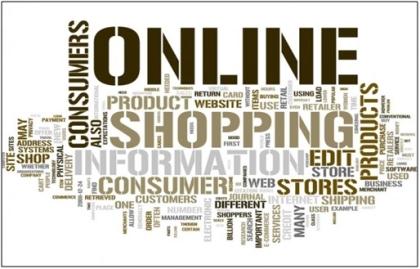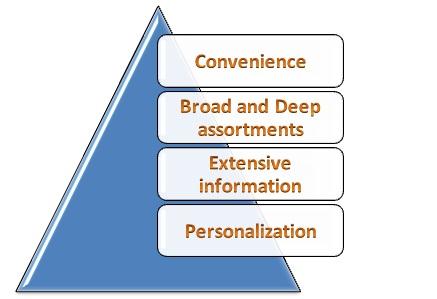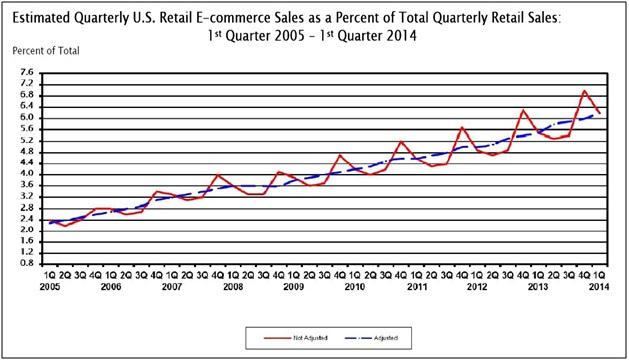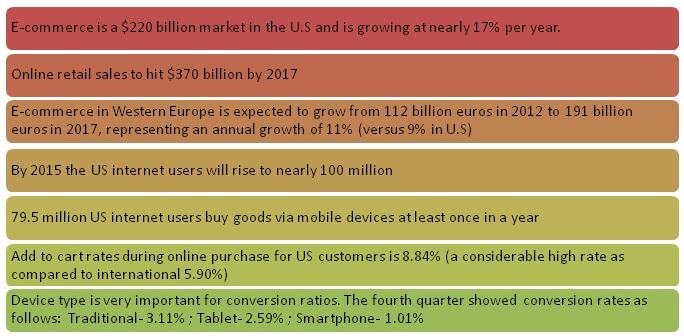- Articles ›
- Operations and IT ›
- E-Commerce - The Game Changing Revolution Articles
E-Commerce - The Game Changing Revolution
E-commerce or electronic commerce, is the buying and selling of products or services using computer networks such as the internet. The concept of online transactions first came into picture in the early 1970s with the world’s first operational packet switching network, ARPANET (Advanced Research Projects Agency Network). Since then it has continued to grow on a massive scale with new technologies and innovations for the last 40 years and has attracted many new businesses to enter the online market. The concept of online store first came into picture with the birth of a little online store called Amazon in 1995.

Benefits of a Business in the online model

1. Low Start-up Costs – The costs related to rent, utility costs, property tax and insurance costs can be minimized through e-commerce as compared to physical stores. Further cost cutting can be made by the reduced number of employees that need to be hired. The only expenses that are incurred include development of a website, a domain name and hosting for the website, purchase of an SSL Certificate and a monthly fee for a payment gateway of choice.
2. Potential Customer Reach- An online store does not limit the target customers to that city or country unlike a physical store and hence caters to a larger customer base.
3. Dynamic Changes-When new products are introduced or the price of a product changes; the only effort needed is to change the price or update the product list from the back end, whereas in a physical store it involves a lot of work including change of price tag, etc.
4. Measured results through online marketing- Online Marketing and Search Engine Optimization can be used to find more qualified customers over the Internet. The result of marketing activities are measurable and changes can be made on the basis of requirements. The marketing campaigns can easily be modified at much lower costs compared to traditional marketing.
Benefits for the Customer in making an online purchase

1. Convenience–An online store gives a customer the convenience of looking at merchandise and placing an order from almost anywhere, 24/7.
2. Broad and Deep Assortment- It is very easy for an e-commerce platform to maintain a vast number of alternatives in terms of SKUs that the customers can consider for purchase. It is very difficult for a store as it depends on the store size and shelf space. Maintaining such large SKUs is also difficult for a catalog channel as the number of SKUs on display is dependent on the number of pages of the catalog.
3. Extensive Information- In a store format the information about a product that can be conveyed to the customer depends on the number of sales executives and the service quality. In an Internet channel vast information regarding the product specifications and appropriate pictures can help the customer in evaluating the product better and solve their problems related to buying decisions. The customers can also interact with the existing customers or view their reviews about products to get a less biased view of the authenticity of the information provided.
4. Personalization- The interactive nature of the Web allows the customer to personalize merchandize offerings and information to encourage economical shopping experience and find products that fulfill their exact needs. Websites like “naaptol” and “flipkart” also allow customers to compare two or more products side by side to choose a product.
The figure below shows the estimated quarterly U.S. retail e-commerce sales as a percent of total quarterly retail sales. It is clearly visible that the shopping behavior of customers are shifting more towards online shopping every year as compared to store shopping.

(Source:www.census.gov/retail/mrts/www/data/pdf/ec_current.pdf)
Data Driven Ecommerce

(Source:http://socialtimes.com/data-growth-e-commerce-infographic_b198687)
The Future of E-Commerce
Currently many online channels allow customers to personalize the products by customizing their products as per their needs. This acts as a POD from other competitors. But amazon has come up with the concept of “Creating your own products” with the introduction of its 3D Printing Store. They allow customers to design and customize products from a catalogue of about 200 items. Customers can choose size, material, color, dimensions, style and image imprints to design their required product. The 3D printing technology is still developing and in the future it can allow the customers to design and upload any product in the world like tech gadgets. (Source:http://www.dubaichronicle.com/2014/07/29/ecommerce-amazon-3d-printing-store/)
Conclusion
The real challenge for a retailer in the present day is from the e-commerce sites like amazon.com, flipkart.com, etc. The busy lifestyles, increased disposable income, huge discounts and enhanced service are the key driving factors for attracting people towards online shopping. The purchase of an item using the online channel is just a click away on your mobile phone or computer and the purchase is successfully completed.
Thus, we see that the revolution called e-commerce has been gracefully accepted by the consumers as a preferred channel for shopping and it is growing year on year. The in-store shopping behavior will slowly decline and make way for e-commerce in the future. As stated by Eddie Machaalani and Mitchell Harper, the Co-CEOs of Bigcommerce,
“By 2022, brick and mortar retail spaces will be little more than showrooms”.
This article has been authored by Amitava Chatterjee from TAPMI
Views expressed in the article are personal. The articles are for educational & academic purpose only, and have been uploaded by the MBA Skool Team.
If you are interested in writing articles for us, Submit Here
Share this Page on:
What is MBA Skool?About Us
MBA Skool is a Knowledge Resource for Management Students, Aspirants & Professionals.
Business Courses
Quizzes & Skills
Quizzes test your expertise in business and Skill tests evaluate your management traits
All Business Sections
Write for Us